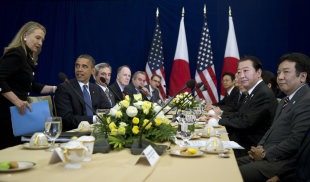GOMA, Congo (AP) — A Rwandan-backed rebel group advanced to within 3 kilometers (1.8 miles) of Goma, a crucial provincial capital in eastern Congo, marking the first time that rebels have come this close since 2008.
Congolese army spokesman Col. Olivier Hamuli said the fighting has been going on since 6 a.m. Sunday and the front line has moved to just a few kilometers (miles) outside the city. After more than nine hours of violent clashes the two sides took a break, with M23 rebels establishing a checkpoint just 100 meters (yards) away from one held by the military in the village of Munigi, exactly 3 kilometers (1.8 miles) outside the Goma city line.
Contacted by telephone on the front line, M23 rebel spokesman Col. Vianney Kazarama said the group will spend the night in Goma.
“We are about to take the town. We will spend the night in Goma tonight,” said Kazarama. “We are confident that we can take Goma and then our next step will be to take Bukavu,” he said mentioning the capital of the next province to the south.
The M23 rebel group is made up of soldiers from a now-defunct rebel army, the National Congress for the Defense of the People, or CNDP, a group made-up primarily of fighters from the Tutsi ethnic group, the ethnicity that was targeted in Rwanda‘s 1994 genocide. In 2008, the CNDP led by Rwandan commando Gen. Laurent Nkunda marched his soldiers to the doorstep of Goma, abruptly stopping just before taking the city.
In the negotiations that followed and which culminated in a March 23, 2009 peace deal, the CNDP agreed to disband and their fighters joined the national army of Congo. They did not pick up their arms again until this spring, when hundreds of ex-CNDP fighters defected from the army in April, claiming that the Congolese government had failed to uphold their end of the 2009 agreement.
Reports, including one by the United Nations Group of Experts, have shown that M23 is actively being backed by Rwanda and the new rebellion is likely linked to the fight to control Congo’s rich mineral wealth.
The latest fighting broke out Thursday and led to the deaths of 151 rebels and two soldiers. On Saturday U.N. attack helicopters targeted M23 positions in eastern Congo.
Also on Saturday, United Nations Secretary-General Ban Ki-Moon had called Rwandan President Paul Kagame “to request that he use his influence on the M23 to help calm the situation and restrain M23 from continuing their attack,” according to peacekeeping chief Herve Ladsous who spoke at the U.N. headquarters in New York on Saturday.
North Kivu governor Julien Paluku said Saturday that the Congolese army had earlier retreated from Kibumba, which is 30 kilometers (19 miles) north of Goma, after thousands of Rwandans, who he says were backing the rebels, attacked early Saturday.
“Rwandan forces bombarded our positions in Kibumba since early this morning and an estimated 3,500 crossed the border to attack us,” he said Saturday.
In downtown Goma, panicked residents had come out to try to get more information on what was happening. A 45-year-old mother of five said that she has nowhere to go.
“I don’t really know what is happening, I’ve seen soldiers and tanks in the streets and that scares me,” said Imaculee Kahindo. Asked if she planned to leave the city, she said: “What can we do? I will probably hide in my house with my children.”
Hamuli, the spokesman for the Congolese army, denied reports that soldiers were fleeing.
In 2008 as Nkunda’s CNDP rebels amassed at the gates of Goma, reporters inside the city were able to see Congolese soldiers running in the opposite direction, after having abandoned their posts. The Congolese army is notoriously dysfunctional with soldiers paid only small amounts, making it difficult to secure their loyalties during heavy fighting.
“We are fighting 3 kilometers from Goma, just past the airport. And our troops are strong enough to resist the rebels,” said Hamuli. “We won’t let the M23 march into our town,” he said. Asked if his troops were fleeing, he added: “These are false rumors. We are not going anywhere.”
U.N. peacekeeping chief Ladsous said that the rebels were very well-equipped, including with night vision equipment allowing them to fight at night.
Reports by United Nations experts have accused Rwanda, as well as Uganda, of supporting the rebels. Both countries strongly deny any involvement and Uganda said if the charges continue it will pull its peacekeeping troops out of Somalia, where they are playing an important role in pushing out the Islamist extremist rebels.
The U.N. Security Council called for an immediate stop to the violence following a two-hour, closed-door emergency meeting. The council said it would add sanctions against M23 rebels and demanded that rebels immediately stop their advance toward the provincial capital of Goma.
“We must stop the M23″ because Goma’s fall “would, inevitably, turn into a humanitarian crisis,” said France‘s U.N. Ambassador, Gerard Araud. He added that U.N. officials would decide in the coming days which M23 leaders to target for additional sanctions.
___
Associated Press writer Maria Sanminiatelli at the United Nations and Rukmini Callimachi in Dakar, Senegal, contributed to this report.
Africa News Headlines – Yahoo! News











